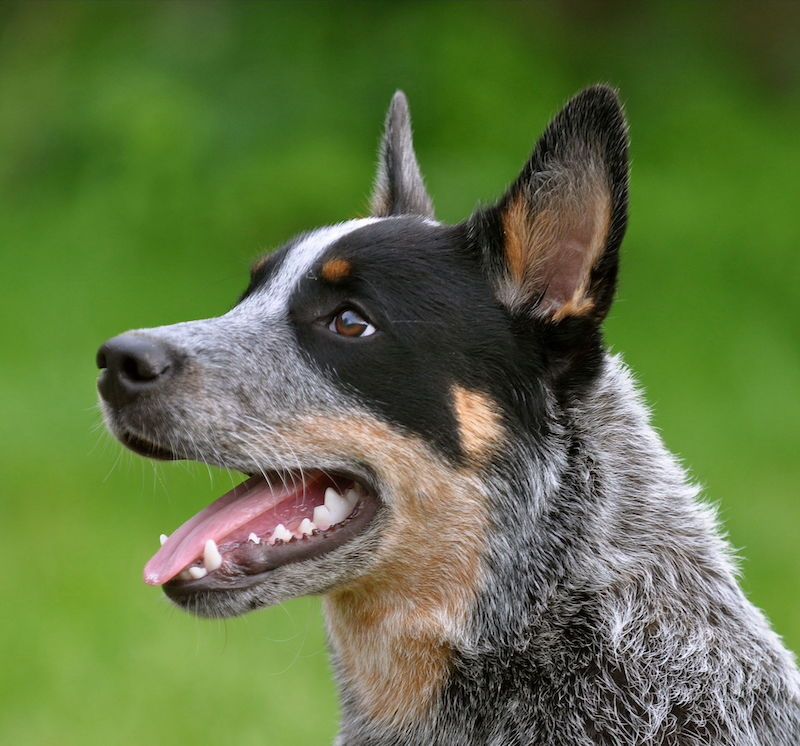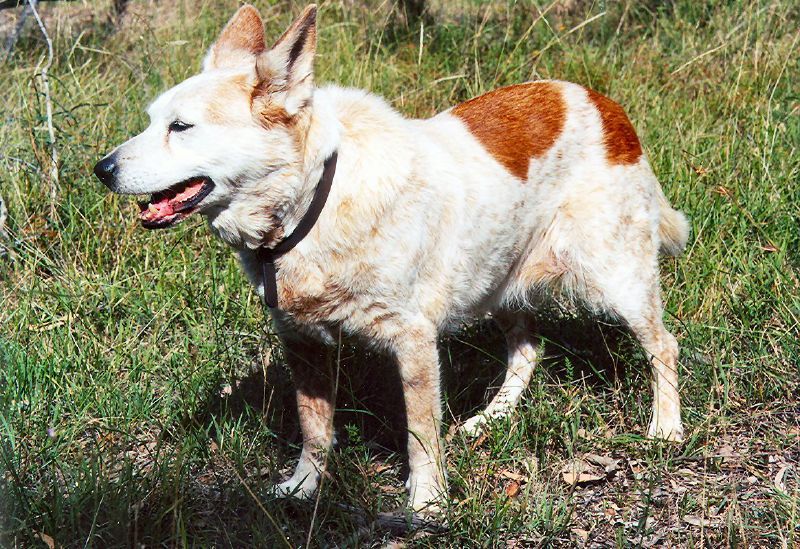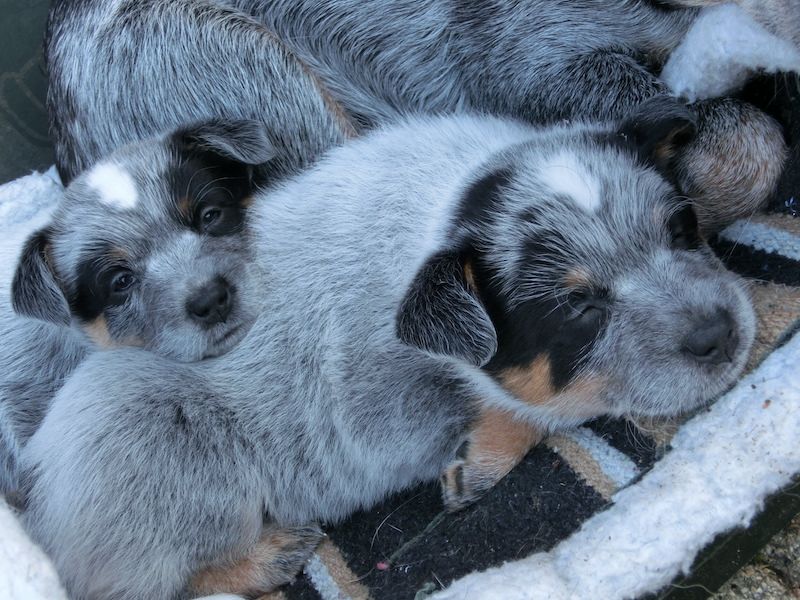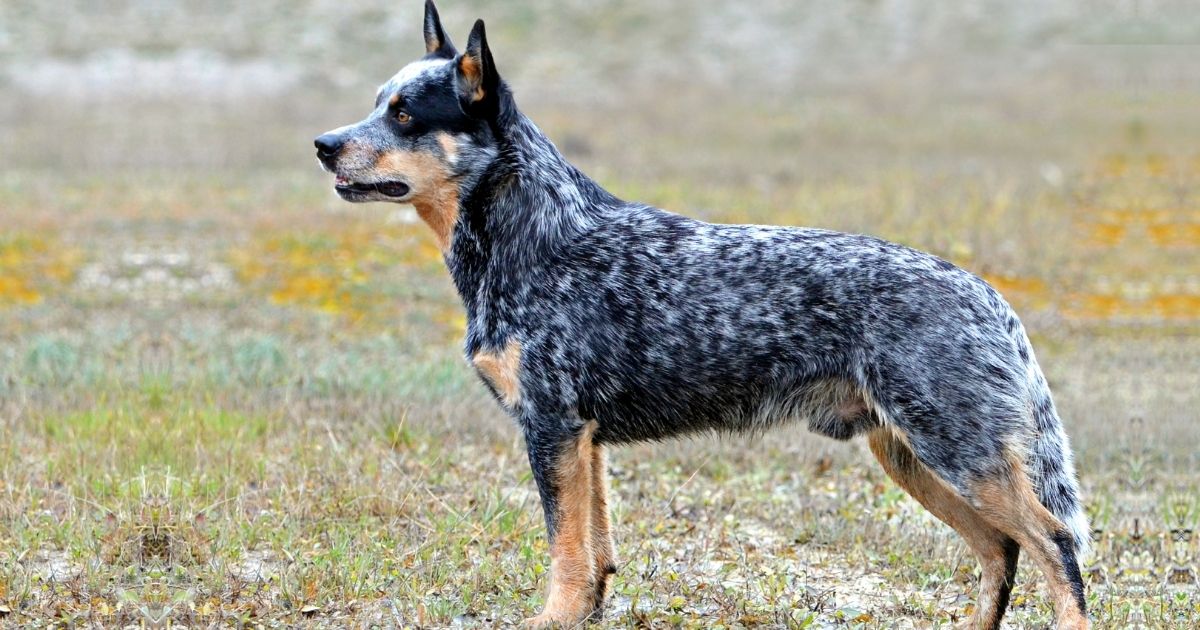The name Australian Cattle Dog brings to mind farmlands with livestock grazing the fields and dogs keeping track of their movements to ensure they are in line.
This dog breed came into existence to do exactly this. Always alert and ready, the Australian Cattle Dog took his herding responsibilities seriously and earned the admiration of Australian farmers.
Currently, they live in other environments outside their home country and play more roles than at the onset.
One thing hasn’t changed, though. The Australian Cattle Dog is still a master at achieving his responsibilities.
Below, you will get various Australian Cattle Dog facts, information characteristics, behavior, temperament, training, grooming needs, and more.
Key Australian Cattle Dog Facts & Information
| Dog Breed Group | Herding Group |
| Height | 17 to 20 inches |
| Weight | 30 to 50 pounds |
| Coat | Short, Straight, Dense |
| Color(s) | Blue, Black, Tan |
| Life Expectancy | 12 – 15 years |
| Temperament / Behavior | Active, Protective, Reserved |
| Origin | Australia |
| Bred For | Herding cattle |
| Nickname(s) / Other Name(s) | Blue heeler, Australian Heeler, Queensland Heeler, Halls Heeler |
| Recognized By | AKC, ANKC, CKC, FCI, KC, UKC |
Australian Cattle Dog Characteristics

| Adaptability | Hard to adapt to an apartment |
| Friendliness | Friendly with family, reserved with strangers |
| Kid-Friendly | Can get along with children |
| Pet-Friendly | Good with dogs; Needs socialization for other pets |
| General Health | A healthy breed, but prone to some conditions |
| Grooming Needs | Low grooming needs |
| Trainability | A trainable breed, but not easy |
| Intelligence | A highly intelligent breed |
| Playfulness | A very playful breed |
| Exercise Needs | High |
| Energy Level | High |
| Tendency to Bark | Low |
| Tendency to Drool | Low |
| Tendency to Snore | Low |
| Tendency to Dig | High |
Interesting facts about Australian Cattle Dog Breed
Fact #1. An Australian Cattle Dog got a Guinness record for the longest canine life span

Many dog breeds have a long life span, but they are expected to step away from this world after 16 or 17 years at the most.
The average life span of the Australian Cattle Dog falls in that category as well. It is a feat for a dog to live longer than 17 years.
That feat was achieved by an Australian Cattle Dog named Bluey. In 1910, Les Hall in Australia got Bluey as a puppy.
Bluey worked as a herder of cattle and sheep for 20 years before retiring. He died on 14 November 1939 at 29 years and 5 months.
Guinness world recorded him as the oldest dog in the world.
Fact #2. They are descendants of dingoes
Wild Dingoes and Blue Merle Collies were crossed to develop the Hall Heeler in 1840.
These Heelers were good at herding cattle by creeping behind them and nipping at their heels.
George Eliot kept on with the breeding, eventually developing the Blue Heeler.
The Blue Heeler caught the fancy of farmers, cattle owners, and two brothers named Jack and Harry Bagust.
They bred the Blue Heeler with Dalmatians and a black-and-tan Kelpie to get the Australian Cattle Dog we have today.
Fact #3. Australian Cattle puppies all have white coat
Before they get the ‘blue’ and ‘red’ color of adulthood, Australian Cattle puppies come in sparkling white fur.
This makes the Australian Cattle puppy a cute furry. As they age, black or brown hair mixes into white, creating the blue and red color we see.
Fact #4. Their coat resists water
Besides their colorful trait, their double coat is resistant to water.
Their fur is like a raincoat that makes water slide off, keeping these dogs dry. This is useful when they herd under the rain.
Fact #5. They were bred to herd cattle
Their name alone gives them away. The Australian Cattle Dog worked with farmers and herders of livestock to herd cattle.
These days, they play the role of companion. However, their herding instinct stays intact.
History & Origin
The Australian Cattle Dog was bred in Australia and worked in large ranches to herd cattle.
They were the perfect match for rebellious cattle as they’d bite and nip the heels of these cattle till they move.
Their development was a result of the desire of farmers to get a strong, rugged dog who would work with the Australian climate and strive in the terrain of that country.
English Sheepdogs like the Smithfield fell short of that standard, so they were bred with a native Australian breed, the Dingo.
The first person credited with breeding English Sheepdogs with the Dingo was Thomas Simpson Hall in 1840.
He took the dogs of his parent’s home county and crossed them with some domesticated Dingoes to develop the Halls Heelers.
After Hall died in 1870, more work continued on this breed. Hail Heelers soon became ancestors of the Australian Cattle Dog and the Australian Stumpy Tail Cattle Dog.
George Eliot was another person who played a big role in the development of the Australian Cattle Dog.
He kept on breeding Hall Heelers and his strain came to be known as Blue Heelers.
In 1893, Robert Kaleski took up from where Eliot stopped and formulated a standard. In 1903, the Kennel Club of New South Wales gave its approval to the standard.
At first, the breed went by the name Australian Heeler, before it became the Australian Cattle Dog. In May 1980, the American Kennel Club recognized the breed.
Australian Cattle Dog Temperament, Behavior & Intelligence

The Australian Cattle Dog may fool a stranger to think he’s a withdrawn canine, but his family knows better.
This affectionate dog is known as a velcro dog because of his ‘clingy’ behavior. Once your Cattle Dog sees you as his favorite, you’ve gotten a shadow.
This isn’t a dog you’d expect to be comfortable without human company.
The Cattle Dog is an active breed with bursting energy. He needs exercise, enough to get him tired.
Not one to be confined in a cramped space, the American Cattle Dog needs a wide environment. Do not isolate him, though.
His loyalty and wariness towards strangers make him a good watchdog, and he’d keep an eye out for strange people.
His wariness shouldn’t be left unchecked, however, as it can turn into aggression. Socialization is necessary.
The Australian Cattle Dog is highly intelligent and can solve problems. Protecting you and your family is his priority, and he does not slack at his job.
Sometimes, he does his job to a fault. The Australian Cattle Dog tends to nip at the heels of people, and will not spare you. Training can curb this habit, though.
If you’re into dog sporting competitions, the American Cattle Dog has a lot of stamina and excels at agility games, tracking, and even obedience.
Your training will go a long way towards influencing his temperament and behavior for the better.
Is an Australian Cattle Dog a good family dog?
The Australian Cattle Dog is loyal to a fault, protective of you and your family, and loves everyone.
These dogs enjoy human companionship and will defend their loved ones when necessary. What more would you need from a family dog?
Of course, not every family will be suitable for the Australian Cattle Dog. The sedentary man and apartment dwellers are examples of people for whom the Australian Cattle Dog will not make good family dogs.
Are Australian Cattle Dogs good with kids?
The Australian Cattle Dog does well with kids, especially when he grew alongside them as a puppy.
It is advisable to bring an Australian Cattle puppy when you have children, not start with an adult. The adult Cattle Dog may feel threatened by a kid and react roughly.
Your children should also learn how to approach a dog with respect and not do things that would be unnerving. The Australian Cattle Dog isn’t so patient.
Are Australian Cattle Dogs good with other dogs and pets?
The Australian Cattle Dog is open to being friends with other dogs, provided they don’t try to drag attention with his favorite in the family. When that happens, he becomes antagonistic towards the other dog.
He can also get along with cats and other pets if he was raised with them. Otherwise, he’ll consider them as prey.
Related: Dogs With High Prey Drive
Male vs Female Australian Cattle Dog
There aren’t many differences between the male and female Australian Cattle dogs. However, the differences can be noticed by someone who’s looking.
Of course, when it comes to gender there’s always an underlying question: Which is better?
For the Australian Cattle Dog, the male is a bit taller, though they share a similar weight.
The male often has a height of 18 to 20 inches while the females are as tall as 17 to 19 inches. Their weight falls between 30 to 50 pounds.
There are some observed personality differences, but note that they aren’t stringent.
Female Australian Cattle Dogs tend to be more aloof, reserved, and territorial while the male Australian Cattle Dog is more laid-back and more friendly. They both make good hunters and companions.
Sometimes, pet parents wonder if it is to have same-sex dogs or two dogs of the opposite sex.
Again, there are no solid rules, but with the Australian Cattle Dog, it is more ideal to have a male-female duo.
After that, the male-male combo is more preferable as their fights don’t get as serious as the females.
Caring for an Australian Cattle Dog

The Australian Cattle Dog is a tough-willed herder, and though herders often make good pets, they don’t come with a simple manual.
For them to successfully integrate into a household, there are many needs you must meet.
The first vital one is a good environment. Herders aren’t couch dogs, and many of them don’t do well in an apartment.
The Australian Cattle Dog can cope indoors when tired, but a house with a yard is better.
They should also be fed, exercised, trained and socialized, groomed, and kept in good health.
Food and Diet
The Australian Cattle Dog is an energetic worker who needs food to sustain his energy.
His diet should be in line with the size, but not to the extent of gifting him with extra weight. That’s not something he’d appreciate in the long run.
The Australian Cattle Dog adult needs about 1½ to 2½ cups, divided into two meals in a day.
This is a general recommendation that may or may not apply to your individual Australian Cattle Dog. Consult a qualified vet or nutritionist to draw out a good plan for your pet.
The Australian Cattle puppy eats more than the adult and should be fed exclusively puppy food. Four times a day is a recommended start when your puppy is 8 weeks.
Older Australian Cattle Dogs don’t use energy like younger ones. They should be kept on a diet that helps maintain their bodily functions without giving them weight.
You could go for premium commercial food, home-cooked meal, or raw food. Commercial food has to meet the requirements of the Association of American Feed Control Official (AAFCO).
A home-cooked meal made by someone else should also submit to the standards of AAFCO. Raw food is approved by some experts and frowned at by others.
Exercise
The Australian Cattle Dog can’t do without a long, vigorous, exercise. Not only does it lead to behavioral problems, but lack of exercise is also unhealthy too.
The Australian Cattle Dog who isn’t out in the field herding has no other way to use up his reserves, except exercise.
How much exercise is enough for the Australian Cattle Dog? For maximum satisfaction, be prepared to exercise your adult Cattle Dog for 1-2 hours at least.
This high requirement cancels out a lot of pet parents. Busy people and those who prefer the indoors may not qualify.
Some good exercises for an Australian Cattle Dog are:
- Walks
- Jogging
- Fetch
- Playing with toys like a herding ball
- Frisbee Toss
The 1-hour minimum suggestion applies only to the adult. Do not exercise puppies to that level.
The Australian Cattle puppy may be energetic, but he is growing and delicate. Exercise should be kept between 10 to 30 minutes.
Seniors need enough activities to keep themselves in good shape and in good health. A simple stroll will do them good.
Training an Australian Cattle Dog is where the fun begins—and the frustrations. You should go for another breed if you’re just starting your journey as a pet parent.
This would prevent having to give up a problematic Cattle Dog for adoption.
The Australian Cattle Dog is intelligent enough to know what you want him to do, but independent thinking may sometimes make him not want to.
Used to doing things on their own, these dogs may not be the most cooperative when it comes to training. They also need an owner who knows how to be in charge.
Start training your Australian Cattle Dog when he’s a puppy and easier to handle.
Behavior is flexible with a puppy than with an adult, so it is easier to correct bad habits and instill good ones when your Australian Cattle Dog is young.
Training should start from home before you get him some formal ones.
For all his stubbornness, the Australian Cattle Dog will learn fast and be obedient if you have proven to be a good leader.
Here are some training processes your Australian Cattle Dog needs:
- Obedience training for control and good manners.
- Socialization to reduce their instinctive suspicion of strangers.
- Exercise and games to keep them fit and stimulate their minds.
Grooming Needs
Grooming an Australian Cattle Dog is a DIY activity and an easy one at that.
Their coat is resistant to water and dirt, meaning they don’t always get soiled and dirty. They don’t shed continually, but have high shedding moments.
With these in mind, here’s what grooming an Australian Cattle Dog entails:
Ear Cleaning
While the Australian Cattle Dog may not have long ears that are vulnerable to ear infections, they need to be clean.
Plus, even dogs with pointed ears may be infected. Clean your Cattle Dog’s ears once a week to wipe out excessive ear wax and dirt. While cleaning, check out for signs of an ear infection.
Bathing
The Australian Cattle Dog doesn’t need a daily bath as his coat protects him from stains and dirt.
Only bathe him when you notice he has gotten himself into a big mess that can’t slide off him.
Coat Care
Brush your Australian Cattle Dog with a bristle or slicker brush once a week.
Increase brushing time and effort when he’s shedding to remove the obsolete hair sticking on his coat.
Paws / Nails Trimming
Like any other energetic dog, the Australian Cattle Dog can get injured if he is allowed to run around with long nails. It also makes him uncomfortable.
With the aid of a trimmer, reduce his nails to a manageable level. Nail trimming should be done once a month, at least.
Teeth Brushing
Prevent mouth odor and other dental-related problems by brushing your American Cattle Dog’s teeth. This should be done at least two or three times a week.
Eyes Cleaning
Eye cleaning is important because a dog’s eyes can accumulate dirt if not cleaned. Using an eye comb, remove muck out of his eyes and clean the surrounding areas with a wipe.
Health Conditions
The Australian Cattle Dog is a healthy breed with the capacity to live long—as was proven by one of them.
They have a few medical conditions they are vulnerable to and need your efforts to maintain their good health.
As part of the efforts, get to know what illnesses may affect your Australian Cattle Dog for you to know what to look out for.
You should get enough information from your veterinarian, but here are some common illnesses you can start with:
Deafness
Deafness is an inherited condition. While getting an Australian Cattle Dog, request for the medical background of the parents.
A dog with deafness should not be bred. Deafness can be temporary or permanent.
Symptoms include lack of attention to your commands, lack of alertness to sound, and excessive barking.
Progressive Retinal Atrophy (PRA)
PRA is an eye ailment that affects the retina and causes it to deteriorate, leading to a loss of vision and eventual blindness.
Symptoms include cloudy vision, a reluctance to move, and frequent accidents.
Hip Dysplasia
Hip dysplasia is another inherited condition that affects the hip joint.
When the femur loosely fits into the pelvis, it is the first manifestation of hip dysplasia. Symptoms include bad movements, reduced activity, and pain.
FAQs
Is an Australian Cattle Dog right for you?
The Australian Cattle Dog is a loyal, devoted, and affectionate dog who loves and protects his family. He bonds with a particular person, but shows love to everyone and doesn’t like being left alone.
That said, they are not ideal for everyone. Only when you can handle his needs will the Australian Cattle Dog be right for you.
What are Australian Cattle Dogs known for?
The Australian Cattle Dog was bred in Australia and was called the Heeler because these dogs were known for nipping at the heels of stubborn cattle to make them move.
Some still herd cattle today, but many are used as family companions.
How big is a full-grown Australian Cattle Dog?
The Australian Cattle Dog has a few pounds and height to fit his energy level. The full-grown Australian Cattle Dog weighs 30 to 50 pounds and grows as tall as 17 to 20 inches.
Do Australian Cattle Dogs like to cuddle?
While Australian Cattle Dogs can cope indoors when tired, they are meant for the outdoors and not suitable as cuddle dogs.
How smart are Australian Cattle Dogs?
As a herder, the Australian Cattle Dog was developed with high intelligence and is capable of solving problems at a fast rate. They learn fast and memorize commands with ease.
Is it hard to take care of an Australian Cattle Dog?
The Australian Cattle Dog can sometimes be daunting to train and exercise, especially if you’ve got zero experience and prefer lounging on the couch all day. However, they are not hard to take care of.
How Long do Australian Cattle Dogs live?
Australian Cattle Dogs have a long life span and may even surpass the maximum. Their life expectancy falls between 12 to 15 years.
How much do Australian Cattle Dogs cost?
Australian Cattle Dogs are not as costly as other dog breeds, but you do need to plan for the purchase. A simple Australian Cattle puppy costs between $400 to $700.
Do Australian Cattle Dogs shed a lot?
Australian Cattle Dogs are minimal shedders but have seasons of heavy shedding. You need to take extra care of their coat during that period.
What does Australian Cattle Dog prey on?
Australian Cattle Dogs were not bred to be hunters, but they have a high prey drive. They may see cats and smaller animals as prey if you don’t socialize them with these pets.
Wrap Up
The Australian Cattle Dog is one you would want to have if your idea of a pet includes outdoor activities, a challenging training moment, and the reward of a guardian who doubles as a friend.
This sensible, intelligent, and devoted breed is a beautiful gift from Australia to the rest of the world.
In the hands of the right owner, the Australian Cattle Dog brings value to his environment and family.
Official Profile and Kennel Club Standards

